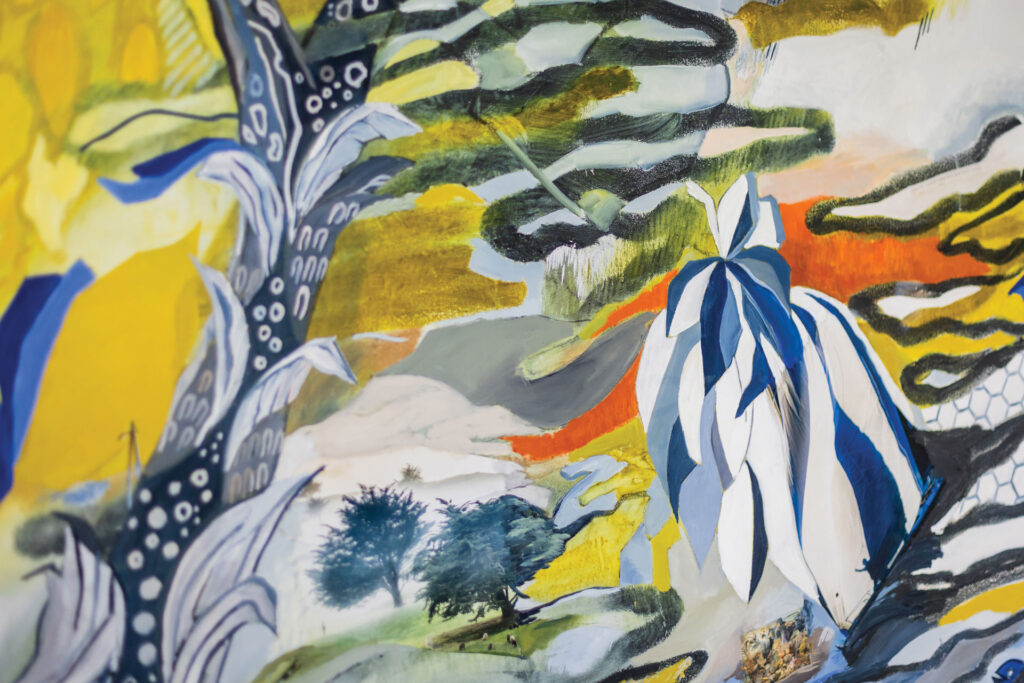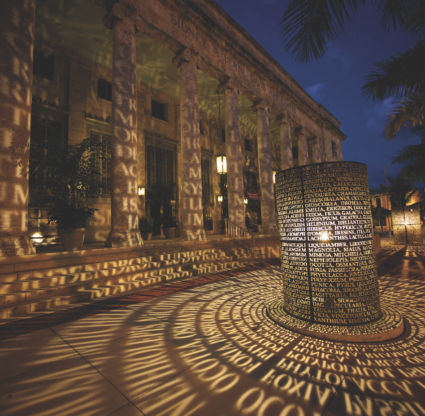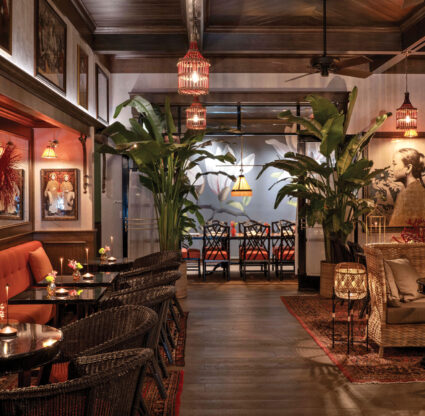“But, this is good.”
Mally Khorasantchi punctuates many sentences this way, speaking in her lilting German accent. Noshing on a dulce de leche-stuffed croissant from Bonita Springs’ Wolfmoon bakery, the artist frets playfully about her figure. “But, this is good.” The reflexive phrase signals her contentment and matter-of-fact wisdom. Overlooking the creek behind the Bonita Springs dream home she and her husband built together—the one completed just months after he suddenly passed away—Mally says the house can feel too big for one person. “But, this is good.”
Mally Khorasantchi is not one to dwell on what could be or what might have been. Her life occurs moment-to-moment, her mind fixed on the present, even when her heart wanders into the past. The last two years have been a shifting tide for the painter, but this period of upheaval—stemming from the loss of her husband and the move from Naples to a verdant tract in Bonita Springs—has settled into a contemplative quietude. Mally’s painting jeans tumble in the laundry more often now as she focuses on a new series: The Sun Also Rises, an apparent opus on life, love and a connection to nature influenced by the flora and fauna surrounding her.
“If you overthink things, you never do this. You know?” she says of immigrating to the United States from Germany some 32 years ago. It was a spur-of-the-moment decision to move halfway around the world. The decision seemed rash to some, but at 43, she still felt young and adventurous. Her kids, by then grown, had moved to the United States. The house in Düsseldorf was too big and the weather too dreary. When Mally Khorasantchi and her husband visited their son for parents’ weekend at University of Pennsylvania, the pair allotted a week for a vacation to Southwest Florida. They quickly fell in love with the silky air and the smells and sounds of nature by the Gulf. “Why don’t we do this?” Mally remembers asking her husband. “Why do we live on the other side of the world with this ugly weather and the Germans, who are not so funny?” In a matter of three months, the two closed on a property in Naples’ Bay Colony community.
Mally paints botanicals—big ones—and abstract scenes interspersed with clippings from her favorite French fashion and architecture magazines. One day, while she flips through a publication, she’s inspired by the flourishing hemline of a pink, ruffled petticoat. Mally neatly slices the image from the page and places it into the woven basket she keeps at her side for just such moments—piecemeal parchment flutters in the container.
The pink fabric’s movement and hue hold meaning, but she hasn’t deciphered it yet—that will take time. First, the artist must remove herself from the work. She’ll read a book, listen to music or sit by the creek and watch the manatees swimming in concert with the easy current. Then, some innocuous word, melody or blooming flower strikes a cord, and the swooping skirt reappears in her mind as a cluster of petals. Soon, this image bleeds into the magenta hues of her 2024 painting The Sun Also Rises VI. There is a narrative behind each of Mally’s paintings. Beneath the billowing petticoat, a bowl of fruit blends into blue, tendril-like leaves; a simple, white bed hides amid the texture of tree bark. In this way, life’s little monotonous moments are framed as part of a natural process—order and chaos in tandem. Everything is as it should be; everything flows along life’s current.

Steal Like an Artist, a book by Austin Kleon, further influenced Mally’s collage works. The author frames art as an iterative process and encourages readers to pluck inspiration from the imagery surrounding them; there is greater meaning in the context of individual experience. The Hidden Life of Trees, by German author Peter Wohlleben, forged Mally’s belief in the interconnectedness of life and nature.
The artist is an avid reader and collects fragments of ideas from books. Last year, Mally Khorasantchi and her lifelong best friend took a cruise to Key West and stopped by The Hemingway Home and Museum. She’d visited the site before, but this time, the artist purchased the author’s first novel, The Sun Also Rises. She hoped the book, where characters search for meaning after tragedy, would help her process the grief of losing her husband, Ali.
Reading the novel, Mally noted the telegrams Hemingway’s characters sent between New York and Europe—it made her think of the many messages Ali sent during business travels. Originally from Iran, Ali ran his family’s oriental rug company and would jet to foreign locales to visit manufacturers. He’d send telegrams back to his wife in Germany: “zur muttertag gratuliere iche liebe dich beste schone mutter der wel: dein mann” (‘Happy Mother’s Day, I love you, the most beautiful mother in the world: your husband.’). His messages were short—each word cost five Deutschmark (roughly $2.50 at the time), but with his voice now gone, each word carries more weight. “Today, we have all the words in the world and nobody cares. It’s overflowing. But this was so short,” Mally says. “I took the telegrams and put all the lines into my paintings. This is recycling my love,” Mally Khorasantchi says. These slices of affection reflect on the importance of our words and find their way into each piece from her current series.
Inside her artsy, eclectic home—which mixes Mally’s modern maximalist, antique and coastal sensibilities—stacks of works-in-progress line the hallway leading to her studio. Before construction ended, the artist worked out of the property’s only existing structure, a backyard shanty surrounded by the tangle of native plants and animals that first drew her to the green oasis near Old 41 Road in Downtown Bonita Springs. She would peer out the window, observing the way Spanish moss dripped from the overhead canopy or how seed pods went from fuzzy to rigid as they dried, and pull these small glories into her work. Mally’s massive canvases barely fit into the cottage, leaving little space to step back and adjust her perspective. To get a good look, the 76-year-old painter would drag her work out into the yard over and over again (no small feat after a spinal fusion in 2021) to check the light and refine each detail.
Once a work is complete, Mally releases it to galleries, museums or private buyers without reluctance. This piece of her was meant to be shared, not hidden away. “A painter is like a storyteller or a dancer,” Mally says. “We have to be naked there and present ourselves. And then, we have to wait for somebody to love us. You’re not really in charge after you make something. That’s the end of your story, but then, it takes its own little trip.”
Over the past decade, Mally Khorasantchi has refined and locked into her aesthetic. The vibrant hues of her modern-day work starkly contrast her paintings before moving to America. Dark-toned works have evolved into her current expressive and emotional style, inspired by Southwest Florida’s natural environment.

While her early work was more subdued, Mally’s personality never was. She was born shortly after the end of World War II in a culture that she says emphasized self-doubt over her natural boldness. Mally was certain she would be an artist, even when life challenged her dreams. At 9, she won an art contest at Düsseldorf’s annual lantern festival. At 12, she lost her father. Two years went by, and Mally began looking at art schools. Then, her mother was diagnosed with cancer. The artist reluctantly attended business school—the more stable option, impressed by her family—and married a man who was only good on paper. By 28, Mally was divorced and had two children. “Then I met my neighbor, later husband, Ali. He was short and Muslim and everything that my mother prayed against,” she says laughing. “But, we made it nearly 46 years, and it was very good fun. We had a wonderful relationship.”
During her years with Ali, Mally Khorasantchi studied art and produced two popular exhibitions in Germany. The couple’s arrival in America, though a welcome change of scenery, once again impeded the artist’s work. She could not paint; she needed to work to get a green card, so for eight and a half years, Mally ran a nail salon, where she learned what it meant to be American. The women she worked with were fiercely independent, fearless and unapologetic—qualities that felt authentically ‘Mally’ in a way Germany never did. The couple became American. Then, they became citizens. Then, Mally returned to her canvas.
She opened a studio in the Naples Design District in 2001—the first studio on Shirley Street, now brimming with artists—and found representation locally with Harmon-Meek Gallery. Her work can be seen in the United States, Germany and Russia. The artist served as president of United Arts Collier between 2010 and 2011, planning events and raising money. She still attends events sometimes, but she’s learned to enjoy solitude and visits from friends. The backyard of her Bonita Springs home provides more than enough inspiration for her creative flow. Her little black cat, Mr. Tucker, stalks birds from behind a screened-in pool, and she drinks sparkling wine in the evenings. It is quiet and beautiful and lively and lonely. “But, this is good.”




